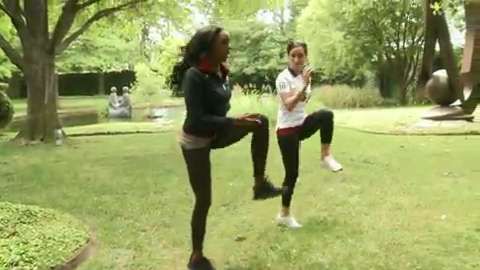While trudging up a monstrous hill, generally all you can think about is hitting the top and finally cruising down the other side—like a dog with his face hanging out the passenger side window on a sunny day, you'll let go and enjoy the ride. Right?
Well, actually, wrong. While uphill running is harder from a cardio perspective, focusing so much on your effort going uphill and ignoring your form going downhill could put you in some big trouble. “The added force of gravity on your muscles and joints when you land can cause muscle damage as the eccentric contractions, or elongating of your muscle fibers, stretch under tension to help your body stay in control with each step you take going down,” says Deena Kastor, Olympic marathon bronze-medalist, who trains daily along California’s hilly coast. “While downhill may feel like free miles on a bike, where you can really let go and enjoy the journey, it’s actually much harder on your body when you’re running." (Looking for a running challenge? Sign up for Women's Health's Run 10 Feed 10 10-K Race!)
In fact, downhill running can be downright dangerous. “The most natural way to go downhill once gravity takes over is to lean back and strike on your heels as a way to brake your body and prevent a fall,” says Steve Scott, a running coach at California State University in San Marcos, California. “Each time you land on your heel, you send a jolt of force and tension through your back, quads, and your hips.” By the time you reach the bottom of the hill, you'd think you just got the recovery you needed after a steep incline, but instead, you stressed your legs and could be feeling even more fatigued (forget about the soreness you’ll feel tomorrow).
That said, the potential problems don't mean you should nix downhill running entirely. A 2006 study published in the Journal of Strength and Conditioning Research discovered that sprinters who trained on uphills and downhills improved their speed and foot turnover more than workouts that only included uphills or flat surfaces.
So what are you supposed to do during that steep decline? Here, a few quick expert tips on the best way to give your downhill running form an upgrade.
Related: 'I Switched To Morning Runs For 2 Weeks—Here's What Happened'
Perfect The Landing
Rather than striking your heels on the pavement, focus on landing on your forefoot, to strike the ground at your center of gravity, Scott says. "Never step in front of your body so that you’re leaning forward. Your body should be centered over your knees."
Improve your running form with these tips from hurdler Lashinda Demus:
Find Your Rhythm
"Most importantly, you want to take lots of small, quick steps to get down the hill," says Scott. A quicker rhythm helps you land softly and spring off the ground more easily (if you hear your feet pounding the pavement you’re doing it wrong). “Your cadence and running form will improve and you’ll be getting your body used to taking more strides per minute which helps you become faster over time.”
Related: 5 Things That Happened When I Tried To Walk 20,000 Steps A Day
Practice On A Gentler Surface
Before you hit the ground running (literally), consider trying out your new running technique on more forgiving terrain. "Since your body absorbs a big impact with each foot strike, start off on a softer terrain, like grass or dirt as you work on your downhill technique,” Scott recommends.
Train Indoors
Your downhill running prep isn't just limited to the great outdoors. Susan Simon, a running coach who teaches the Equinox Precision Running class in New York City, suggests preparing for your downhill runs by adding step-downs to your indoor strength-training routine. Start first with a low height—no more than a six-inch step or the bottom step stairs at your home. Stand on top of the step. Using one leg at a time, step down to the floor with one foot, and immediately step down with the other foot, then return back to the starting position on top of the step. Continue doing this for 10 reps, then alternate the starting leg, and repeat for three rounds total. “This mimics the action of your stride moving downhill with your front leg lowering first, and stabilizing the knee and hip of the back leg,” says Simon.
Related: These Are The 4 Best Leg Exercises For People Who Want To See Serious Results
A variation of this, or a quick warmup pre-run, can be done without a step: Start with balancing on your left leg and bend forward at your hip as you extend your right leg forward towards the ground maintaining a straight or slightly bent leg, attempting to reach your foot as far forward as you can, just tapping the ground (similar to a pistol squat). Stand back up on the balanced leg in between reps (your lifted knee does not need to break 90-degrees). Do 10 reps on each side.
By incorporating downhills into your training you can handle them better, save your body from future injuries and literally make or break your performance during your next race. PR, here you come!














